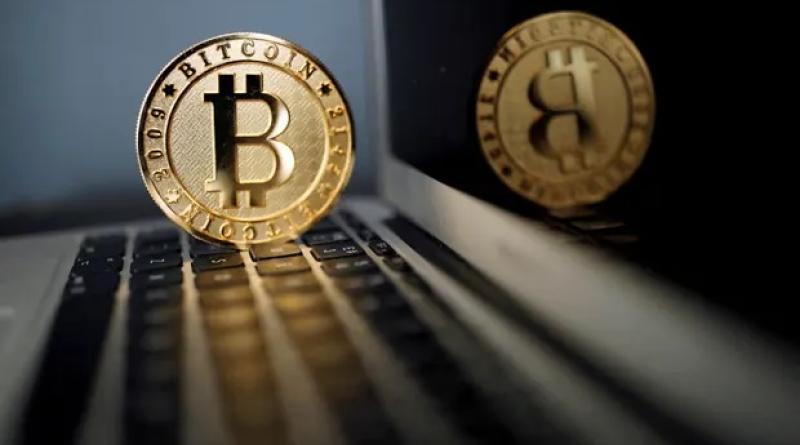Bitcoin is terrible for the environment – can it ever go green?

On the corner of New York’s Park Avenue and 52nd Street, curious onlookers recently stopped in front of a giant green skull sitting in the bed of a truck parked outside the office of Fidelity Investments, the global financial management company.
The “Skull of Satoshi”, named after the pseudonymous bitcoin developer Satoshi Nakamoto, is composed almost entirely of computer circuit boards and fitted with tall smokestacks usually found atop coal power plants.The artifact is a project of artist Benjamin Von Wong and is a reference to the massive amounts of carbon emitted from mining the cryptocurrency bitcoin, an endeavor Fidelity is now pursuing.
Bitcoin is chiefly known as a wild investment vehicle that – along with many other cryptocurrencies – can seemingly make or lose fortunes overnight in a market where values go up and down quickly and by large margins.
But what worries environmentalists and others is the huge amount of electricity used in generating bitcoin and other such currencies – energy that often traces back to fossil fuels and so has a corresponding impact on the climate crisis.
As major financial brands speculate in the cryptocurrency world, environmental campaigners want to make sure they know that they are not just taking a financial gamble; there is also an environmental risk.
Some are hoping that they can persuade those institutions to try to lessen the impact of crypto-mining. “It’s a big step for a financial institution like Fidelity to launch their own crypto platform. So now more than ever, we need their help,” said Rolf Skar, campaign director at Greenpeace USA, a non-profit environmental advocacy organization.
It is a complex situation. But here is a guide to the key issues.
What is bitcoin?
Bitcoin is a type of cryptocurrency, a decentralized form of currency that is strictly digital rather than physical – unlike dollars, pounds or euros. It is managed and traded on a public, open ledger known as a “blockchain” that records all bitcoin transactions. Though not commonly done, bitcoin can be used to buy material goods.
How does bitcoin cause environmental damage?
Because cryptocurrencies such as bitcoin are not centralized, there is no singular authority or body to verify transactions. Instead, participants in the bitcoin network “mine”, or compete to solve cryptographic puzzles to generate more of the currency. Whoever solves the puzzle the fastest gets to verify transactions for the chance to add the newest batch of them to the blockchain.
The winner is financially rewarded with new cryptocurrency in this process, referred to as “proof of work” (PoW) – the culprit for greenhouse gas emissions.
The PoW consensus algorithm used to verify transactions requires large amounts of electricity which is often produced by burning fossil fuels, emitting carbon dioxide and other greenhouse gases that are heating the planet.
A 2022 report, titled Revisiting Bitcoin’s Carbon Footprint, conducted by climate and economics researchers across Europe estimates that “Bitcoin mining may be responsible for 65.4 megatonnes of CO2 per year … which is comparable to country-level emissions in Greece (56.6 megatonnes in 2019).”
What do environmental groups want?
There is a recent push by some environmentalists to reduce the environmental impact of bitcoin by changing the way it is produced
So groups such as Greenpeace are calling out Fidelity and other financial management and payment process companies that have ventured into bitcoin mining. Hence the recent targeting of Fidelity. Skar said that although Fidelity responded to Greenpeace when the group reached out, the response was lackluster.
“[Fidelity] seem not to want to talk about the issue. They declined [our request to speak] so far, but it’s an invitation for them and others to step up and put resources towards solutions to deal with the problem of bitcoin mining globally. We think it can be done,” Skar said.
How could ‘changing the code’ mitigate environmental damage?The solution, Greenpeace argues, is simple: change the computer code that produces bitcoin in order to consume less electricity and reduce its carbon footprint.This code is open-source, meaning it is publicly accessible to anyone who wants to see or use it.
Rather than a PoW verification process, which requires vast amounts of energy, climate activists are arguing for a less energy-intensive verification process that isn’t reliant on speed, such as “proof of stake” (PoS), used by ethereum – another cryptocurrency.
How is this Fidelity’s problem?
Since bitcoin is decentralized, it has no owner and no one to hold to account for problems the cryptocurrency creates, like wreaking havoc on the environment.
The activists advocating for a code change to bitcoin argue that popular financial services corporations like Fidelity have the clout to incentivize such a change, which would be environmentally transformative.
“[Fidelity] doesn’t have a climate commitment like other asset managers. Fidelity is the focus because they have been one of the biggest traditional financial players involved in the bitcoin space and they refuse to acknowledge that they have a responsibility and the ability to help fix the problem that bitcoin mining is having on the climate. So this is actually an invitation for them,” Skar said.
He called the code change “a win for bitcoin and for climate and for communities”.
But would it succeed?
Prominent voices in the bitcoin community and some scholars on the topic don’t buy into this solution.
Dr Hanna Halaburda is an associate professor of technology, operations and statistics at NYU’s Stern School of Business. Among the classes she teaches are Blockchain and Cryptocurrencies and Foundations of Fintech.
In reference to a hypothetical bitcoin protocol change, Halaburda said: “I don’t think it’s going to work. Everybody recognizes [bitcoin] is environmentally unhealthy, but any big changes to bitcoin protocol have been very unsuccessful because you need to get all the miners to agree on that.”
Any miners that don’t agree with the protocol change can simply reject the new code and continue running the original code that relies on the energy-intensive PoW.
Would other tactics work?
Halaburda said there might be another solution: renewable energy.
“A lot of [bitcoin] mining companies have set up their contracts with renewable energy companies. The argument is that having these mining facilities as clients means that when there’s an oversupply of energy, it may actually make it more profitable for the renewable energy plants,” she said.
This means that these energy companies can mine bitcoin during periods of excess production and oversupply. So instead of letting energy go to waste, money can be made and the wealth can be shared between the cryptocurrency mining facilities and the renewable energy companies with which they have a contract.
cover photo: The amount of carbon dioxide produced by bitcoin mining each year may be comparable to the amount emitted by Greece in 2019. Photograph: Benoît Tessier/Reuters





